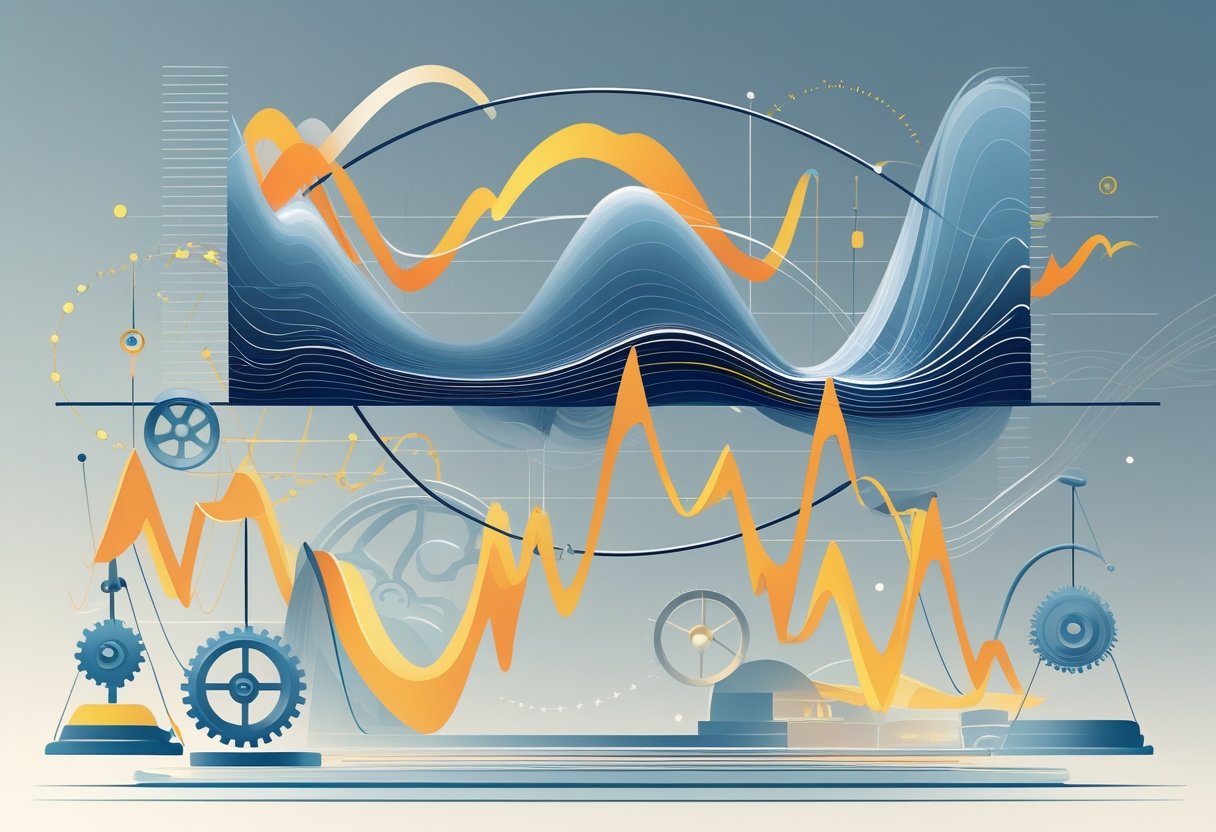Have you ever noticed how your body's energy can change a lot during the day? These shifts, called energy fluctuations, are not just personal feelings. Energy fluctuations describe the small, random changes in energy that happen in physical systems, from your body to the tiniest particles in physics. Scientists study these changes to understand everything from how hot objects cool down to the way particles behave at the smallest scales.

Energy fluctuations are a key concept in both classical and quantum science. In classical models, these shifts happen because particles are always moving and bumping into each other. In quantum physics, even “empty” space has energy fluctuations, known as quantum fluctuations, which can cause brief and random changes in energy.
Key Takeaways
- Energy fluctuations are small, random changes in energy seen in many systems.
- They play an important role in both classical and quantum science.
- Understanding them can help explain real world and atomic scale phenomena.
Understanding Energy Fluctuations
Energy fluctuates in many physical systems, both at large scales like weather and at atomic scales in chemistry and physics. These changes can be traced back to thermal effects, environmental influences, and even the nature of quantum physics.
Definition and Fundamental Concepts
Energy fluctuations refer to the small, random changes in the energy of a system over time. In science, this is common in systems that exchange heat or particles with their surroundings. When temperature is held steady in a closed system, the energy still moves up and down in a predictable pattern.
In statistical mechanics, these changes are measured as the root mean square deviation of energy values from their average. This means scientists can predict how much the energy might “wiggle” around its mean value under set conditions. Even in perfect conditions, energy fluctuations are impossible to avoid because of the random nature of molecules and atoms. When a feature like temperature is kept constant, another feature like energy will naturally show these small, random jumps, as explained in ScienceDirect's overview of energy fluctuation.
Sources of Energy Fluctuations
There are multiple sources that cause energy fluctuations in different systems:
- Thermal Energy: Heat moving in and out of a system always causes small changes in energy, especially when the system interacts with its environment.
- Particle Exchange: In open systems, the number of molecules can change, leading to extra fluctuations tied to the movement of these particles.
- External Forces: Changes like pressure, electromagnetic fields, and collisions can trigger shifts in energy.
In chemical or physical labs, these can be tracked by monitoring specific conditions. For example, in a beaker of water at a set temperature, the amount of heat energy shifts even when nothing obvious is happening. In physics, the energy fluctuation in an open system equals that in a closed, isothermal system plus a part that depends on changes in particle number, as shown at ScienceDirect.
Difference Between Energy and Quantum Fluctuations
Energy fluctuations are classical changes that happen due to temperature, environment, and particle movement. These are found in everyday objects, lab experiments, and ordinary matter. They can be calculated and often controlled by changing the system's surroundings.
Quantum fluctuations, in contrast, are unique to quantum physics. They refer to the random, temporary changes in the amount of energy at a single point in space, even when everything else stays the same. Quantum fluctuations do not need outside triggers; they happen because of the Heisenberg Uncertainty Principle, which says certain properties of particles like energy and time can never both be perfectly known. This makes their origin and effects different from classical energy fluctuations, as described by Wikipedia’s explanation of quantum fluctuation.
Here is a short comparison table:
| Feature | Energy Fluctuations | Quantum Fluctuations |
|---|---|---|
| Cause | Temperature, particles | Heisenberg Uncertainty |
| Scale | Macroscopic, atomic | Subatomic |
| Can be Controlled? | Yes, often | No |
| Mostly Seen In | Physical, chemical systems | Quantum fields, vacuum |
Statistical Mechanics and Energy Fluctuations
Statistical mechanics explains how energy randomly moves and changes in systems made of many particles. Energy fluctuations can help describe how microscopic actions add up to create real-world results.
Role in Statistical Physics
In statistical physics, energy fluctuations are seen as small changes in the energy of a system, like gas in a box. Systems at a constant temperature do not keep the same energy all the time. Instead, their energy changes from moment to moment due to particle movement.
The canonical ensemble is often used to study these energy changes. Here, the system can trade energy with its surroundings but keeps the number of particles and volume fixed. The average energy is stable, yet the actual energy can shift.
Energy fluctuations are measured using the root mean square deviation from the average energy. This value helps scientists relate microscopic properties to what is seen in the lab. For more details about energy fluctuations, see the overview on energy fluctuations in the canonical ensemble.
Fluctuation Theory
Fluctuation theory studies the size and pattern of energy changes in systems at equilibrium. These fluctuations are random deviations from the mean state.
Thermal fluctuations arise when particles gain or lose energy, even if the overall temperature remains constant. The variance of energy gives information about how large these changes can be. The size of the variance often depends on the system size and temperature.
Fluctuation theory helps connect events at the atomic level to bigger, everyday observations. It is key for predicting physical properties like heat capacity and understanding why some properties stay the same and others change. To learn more about the basics of fluctuations, visit thermal fluctuations on Wikipedia.
Energy Fluctuations in Quantum Systems
Energy in quantum systems does not stay fixed, even in what appears to be empty space. These energy changes impact the behavior and stability of systems at the quantum level.
Quantum Fluctuations and the Vacuum
Quantum fluctuations are brief, random shifts in energy that take place even in a vacuum. Unlike classical physics, where a vacuum means complete emptiness, quantum physics says a vacuum is filled with fluctuating fields and energy.
These fluctuations happen because of limits set by the Heisenberg Uncertainty Principle, which states that it is impossible to measure both the energy and time exactly at the same time. As a result, small temporary shifts in energy occur everywhere, even in the absence of matter. This activity is also called quantum fluctuation.
Virtual particles can appear and disappear during these quantum fluctuations, but usually, they last for a very short moment and cannot be directly observed. The idea of a vacuum, therefore, is not the absence of everything, but a space with constant energy changes.
Impact on Quantum Mechanics
Quantum fluctuations are at the heart of many strange effects in quantum mechanics. They can influence forces between particles and can even create temporary changes in the density of energy across space.
In quantum mechanics, these fluctuations affect measurements and the states of particles. For example, due to quantum fluctuations, the energy inside an atom is never perfectly stable. This leads to small but measurable changes, such as the “Lamb shift” in hydrogen atoms.
Quantum fluctuations also play a role in larger phenomena, such as the structure of the universe. They are believed to be responsible for the tiny differences in energy that eventually led to the formation of galaxies. Researchers continue to study energy fluctuations and their impact through experiments and advanced theories.
Energy Fluctuations in Classical Models

Energy fluctuations in classical systems depend on the physical model being used. Different systems, like the harmonic oscillator and the ideal gas, display unique patterns of energy change based on temperature, system size, and the rules of classical mechanics.
Harmonic Oscillator
A classical harmonic oscillator is an object that moves back and forth when attached to a spring or similar force. Its energy, made up of kinetic and potential parts, changes smoothly over time.
At thermal equilibrium, the mean energy of the oscillator depends on the temperature. The energy fluctuation is calculated using the formula:
- Energy fluctuation = ⟨E²⟩ – ⟨E⟩²
For a single harmonic oscillator in a thermal bath, the energy fluctuation depends on temperature and follows the rules of statistical mechanics. As the temperature rises, the energy and its fluctuation both increase.
Classical models do not show the same random, temporary changes seen in quantum models. In fact, energy-level fluctuations are much smaller for the classical oscillator. This leads to more stable, predictable motion.
Ideal Gas Behavior
An ideal gas is made up of many particles that move freely and collide with each other but do not interact otherwise. Each particle has its own energy due to motion.
The total energy of the gas changes with temperature and the number of particles. The energy fluctuation in an ideal gas is calculated using the formula for variance in energy:
- Energy fluctuation (variance) = kT² (∂⟨E⟩/∂T), where k is the Boltzmann constant.
If the number of particles is large, energy fluctuations become small compared to the total energy. This is why in a macroscopic sample, the temperature and energy seem very stable.
In an open system, energy fluctuation is also linked to particle number fluctuation. Detailed discussion can be found by looking at energy fluctuation in open systems. For very small systems or when the number of particles is low, these fluctuations become more important and noticeable.
Computer Simulations of Energy Fluctuations

Computer simulations are an essential tool for studying energy fluctuations. They allow scientists to predict how energy changes over time at atomic, molecular, and even larger system levels.
Modeling Techniques
Researchers use different modeling techniques to simulate energy fluctuations. One common approach involves dividing large systems into smaller blocks or regions, then measuring local energy changes inside each one. This block method helps in identifying patterns of energy localization and excess fluctuations within the system.
Stochastic modeling is also popular. In this method, random changes are introduced into the simulation, which represents real-life uncertainties. Programs may use techniques like molecular dynamics, Monte Carlo simulations, or specialized plasticity models for metals. These simulations are often run many times to gather a broad set of results, helping scientists understand the range and distribution of energy fluctuations under various conditions.
Some software uses quantum fluctuation relations to compute properties like free energy. They rely on dynamic simulations that do not start at equilibrium but eventually help estimate how much the free energy changes in a system over time.
Applications in Scientific Research
Computer simulations help answer important questions in physics, chemistry, and materials science. They are used to study how energy spreads in chains of interacting beads or atoms, which can model real physical systems like molecules or granular materials.
Scientists use simulations to predict behavior in extreme environments, test new materials, and develop better energy devices. For example, simulating how energy fluctuates in porous metals can improve designs in construction and manufacturing.
Recent work also uses simulations to analyze quantum systems. By applying fluctuation relations, these tools help compute free energy differences and other important features even under non-equilibrium conditions.
A key strength of computer simulations is that they let researchers explore scenarios that are hard or impossible to test in the lab, making them a critical part of modern science.
Significance and Applications of Energy Fluctuations
Energy fluctuations play an important role in both technology and nature. These fluctuations affect the design of energy systems and help explain patterns in the natural world.
Technological Implications
Energy fluctuations are key to how certain technologies operate and perform. For example, in renewable energy, daily and seasonal changes in wind and sunlight cause random shifts in the amount of energy produced. This makes it necessary to use batteries and smart grids that can handle and store energy efficiently to balance supply and demand.
Devices that capture and use energy from temperature changes can actually use these fluctuations to generate electrical power. Materials with high thermal effusivity are able to harvest energy from quick temperature changes and can power small devices, sensors, or wearable technology. Learn more about how new materials help with energy harvesting from temperature fluctuations.
Engineers also need to account for energy fluctuations when building small machines and electronics, since changes in energy can affect the stability and operation of these systems.
Impacts on Natural Phenomena
Energy fluctuations influence many processes in the environment. For instance, random changes in solar energy reach the Earth's surface and impact weather patterns and temperatures throughout the year.
In biology, small variations in energy can affect the way molecules move and interact inside living cells. These changes impact chemical reactions that keep organisms alive. Scientists study these fluctuations to understand how life reacts to changing environments.
On a larger scale, energy fluctuations in wind and ocean waves are important for building predictions in climate science. They explain shifts in patterns like storms, droughts, and other weather events. More on this can be found at energy fluctuation in natural cycles.
Future Directions and Research in Energy Fluctuations
Advances in technology and theory are shaping new research into energy fluctuations. Researchers are using new tools and ideas to better understand and control how energy varies across different systems.
Emerging Experimental Methods
Scientists are now using advanced sensors and high-speed cameras to track energy fluctuations in real time. This helps them spot rapid or random changes in energy in systems like fluids, biological materials, and power grids. For example, studies using sensitive instruments have explored how bacteria move in fluids by monitoring tiny energy changes, giving clues about the behavior of living organisms.
Engineers design experiments to measure daily and yearly cycles in wind power. They build detailed models from the data to predict future energy supply and demand changes. Other tools, such as advanced voltage sensors, help to address power quality in renewable energy systems by detecting fast fluctuations and correcting them on the spot. This helps grid operators handle unexpected swings more smoothly.
Open Questions in Theoretical Physics
Theoretical physicists face several open questions about energy fluctuations. They want to know how random fluctuations influence the stability of large systems and why some systems recover quickly while others do not. Some theories focus on how quantum effects might impact energy at very small scales, looking at the differences from classical systems.
A key challenge lies in predicting large, rare fluctuations that can cause major changes or failures in systems, such as sudden blackouts. Understanding the math behind these rare events could lead to better ways to design safer power plants and improved grids. Researchers also explore the link between energy fluctuations and the overall complexity of systems, such as how market energy price changes are affected by various outside influences.
Frequently Asked Questions
Energy levels are not steady and can change due to multiple physical, mental, and environmental factors. These changes can be tracked, explained by science, and managed using practical methods.
What are the primary causes of fluctuating energy levels in individuals?
Daily habits, nutrition, and sleep are common reasons for changes in energy. Stress, illness, and medications may also play a role.
Physical activity and mental health issues like anxiety or depression can make energy go up or down. Environmental factors such as temperature and light also contribute.
How can energy fluctuations be quantified and modeled?
People track energy use or production with sensors and meters. Scientists use mathematical models to predict and measure these changes over time.
Energy usage at home or in devices is often displayed on dashboards that show large fluctuations even if daily routines do not appear to change.
What is the impact of quantum fluctuations on energy systems?
Quantum fluctuations are small changes that happen at the atomic or subatomic level. These changes can affect energy systems that rely on precise measurements.
In some cases, devices and experiments must account for these tiny shifts, especially in sensitive scientific equipment.
What significance do energy fluctuations have within statistical mechanics?
In statistical mechanics, energy fluctuations help explain how particles in a system move or interact. These random changes are important for understanding temperature, pressure, and other physical properties.
They provide clues about how energy moves within large groups of particles.
How do erratic energy levels typically manifest in daily activities?
People notice erratic energy as sudden tiredness or bursts of energy without a clear cause. It may affect mood, focus, and the ability to do chores or work tasks.
Unpredictable energy can lead to skipping meals, inconsistent exercise, or trouble sleeping.
What strategies are effective in managing unpredictable energy patterns?
Sticking to a regular sleep schedule and eating balanced meals can help reduce changes in energy. Physical activity and stress management, like deep breathing, also make a difference.
Tracking daily habits and making small adjustments can make energy more steady. Talking to a doctor is important if energy swings are severe or long-lasting.
Conclusion
Energy fluctuations happen in many forms and systems. They can be noticed in daily life through weather patterns, power supply, or even body energy levels. These changes are often random or happen in cycles.
In physics, energy fluctuations appear in open and closed systems. They relate to random changes, particle movement, and system temperature. Scientists observe these patterns to help understand how energy moves and changes form. In open systems, energy fluctuations also depend on the number of particles present, which can change over time.
For example:
| System Type | Fluctuation Cause |
|---|---|
| Open System | Energy & particle number changes |
| Closed System | Energy changes only |
People may notice energy fluctuations as changes in their own energy throughout the day. Fatigue and sudden bursts of energy are normal and show how the body’s energy supply is always shifting. More about these experiences can be read in articles focused on energy levels and fatigue.
In technology, energy fluctuations impact how reliable wind or solar power can be. These changes make it important for engineers to design systems that can adapt to the daily and seasonal shifts in energy supply. More information can be found on energy fluctuation patterns.
Key Points:
- Energy fluctuations are normal and widespread
- They affect physical, biological, and technological systems
- Awareness of these changes helps make better predictions and decisions

